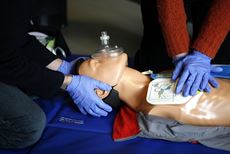

National Institutes of Health
When someone's blood flow or breathing stops, seconds count. Permanent brain damage or death can happen quickly. If you know how to perform cardiopulmonary resuscitation (CPR), you could save a life. CPR is an emergency procedure for a person whose heart has stopped or is no longer breathing. CPR can maintain circulation and breathing until emergency medical help arrives.
Even if you haven't had training, you can do "hands-only" CPR for a teen or adult whose heart has stopped beating ("hands-only" CPR isn't recommended for children). "Hands-only" CPR uses chest compressions to keep blood circulating until emergency help arrives. If you've had training, you can use chest compressions, clear the airway, and do rescue breathing. Rescue breathing helps get oxygen to the lungs for a person who has stopped breathing. To keep your skills up, you should repeat the training every two years.
- Heart Attack Help? There's an App for That (06/22/2016, HealthDay)
- Adult First Aid/CPR/AED Ready Reference (American Red Cross) - PDF
- Hands-Only CPR (American Heart Association)
- Learn CPR You Can Do It! (University of Washington, School of Medicine)Also in Spanish
- CPR - adult - slideshow Also in Spanish
- CPR - child 1 to 8 years old - slideshow Also in Spanish
- CPR - infant - slideshow Also in Spanish
- CPR: Adult
 (American Red Cross)
(American Red Cross) - CPR: Infant
 (American Red Cross)
(American Red Cross)
- CPR Facts and Stats (American Heart Association)
- ClinicalTrials.gov: Cardiopulmonary Resuscitation
 (National Institutes of Health)
(National Institutes of Health)
- American Heart Association
- American Red Cross Also in Spanish
- Find a course (American Heart Association)
- National Heart, Lung, and Blood Institute

- CPR (For Parents) (Nemours Foundation)
- CPR: A Real Lifesaver (For Kids) (Nemours Foundation)
- Pediatric First Aid/CPR/AED Ready Reference (American Red Cross) - PDF





















.jpg)












No hay comentarios:
Publicar un comentario